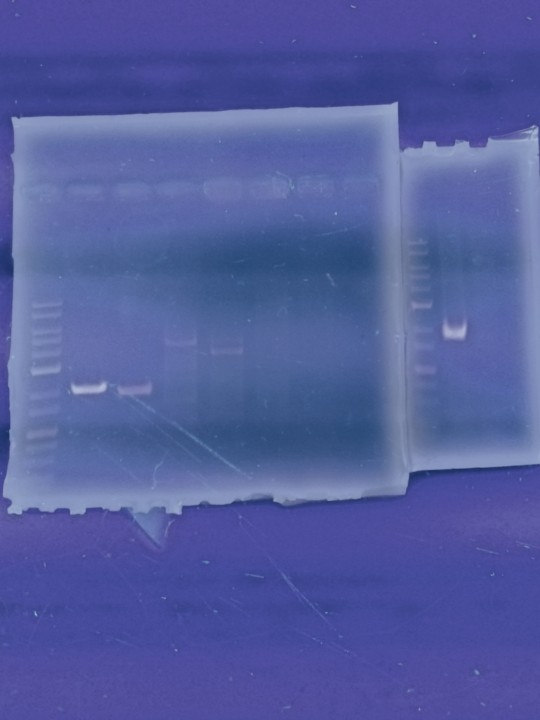#microbiology and molecular biology
Text
A monoclonal antibody appears effective at neutralizing the numerous variants of SARS-CoV-2, as well as related viruses in animals that could pose a threat if they were to begin spreading in people. The antibody, called SC27, was recently described in an article published in Cell Reports Medicine.
The finding opens the possibility of broader, more effective treatments to work against current and future COVID variants.
Continue Reading.
180 notes
·
View notes
Text
I was in bio the other week and thinking about mitochondria (as you do) and I kept thinking about a heavy metal poster that was mitochondria and like

I did it lol
#u can get this on my Redbubble btw!!#mitochondria#mitochondria is the powerhouse of the cell#biology#bio#microbiology#cells#molecular biology#cell biology
320 notes
·
View notes
Text

13.03.2024, wednesday
i know it has been a while since my last update but i have a good excuse (i don’t)
sometimes it is really hard to find enough motivation to study, read articles and write my thesis; and as a bonus, it seems like i cannot catch a break from microbes, is it just me or has everyone become ill this winter?
anyways, i am back and very much ready to rock this semester AA style, hehe
today’s goals:
1. reading the article which will be presented by one of my classmates tomorrrow and writing audience report
2. doing literature research about MALDI-TOF for bacterial identification
3. finding the third and final article which i will be presenting in class
#academics#grad school#grad student#graduate school#gradblr#molecularbiology#msc#new studyblr#stem#study#study aesthetic#studyblr#study motivation#study blog#molecular biology#microbiology#women in stem#article
13 notes
·
View notes
Text
Plasmid Vector
-- most common cloning vector
-- self-replicating
-- found in prokaryotes
-- 20,000 base pairs or less
#studyblr#notes#my notes#microbiology#microbio#microbiology notes#microbio notes#molecular biology#microorganisms#pathogens#biology#bio#biology notes#bio notes#science#life science#biological science#health science#laboratory science#microscopy#microbial organisms#bacteria#bacteriology#note cards#flashcards#flash cards
25 notes
·
View notes
Text

aaahhh school started today, i'm taking 4 courses which is a first for me and i reallllyyyy don't wanna have to drop anything bc it would set me back for next year but i also wanna learn everything there is to learn in these courses and do really well AND Not Be Stressed- can i do this idk aaaaaahhhhhh
day 74 // 100dop
wrote down all the due dates (my god there are so many due dates 🫠)
finished 1/4 psych readings (i swapped the calculus for psych since i need more time to review high school math)
finished notes on 8 slides for microbiology
finished notes on 13 slides for molecular bio
finished notes on 15 slides for biochem
day 44 // 100doc (yesterday)
finished fiftyville
finished html/css/javascript lecture
started lab 8
#cs50#100 days of code#100dop#100 days of studying#100 days of productivity#studyblr#stemblr#stem student#stem academia#codeblr#progblr#biochemistry#molecular biology#microbiology#psychology#bioblr#premedblr#chaotic academia#chaotic academia aesthetic#hogwarts aesthetic#dark academia#dark academia aesthetic#heyfrithams#heyharri#heydilli#mittonstudies#heyzainab#myhoneststudyblr#benniscup
20 notes
·
View notes
Text

Within the cell, a symphony untold,
A dance of molecules, secrets unfold.
DNA's twisted ladder, a spiral divine,
Holds blueprints of life, in each intricate line.
From single-celled whispers to towering trees,
A tapestry woven on life's swirling seas.
Bacteria's whispers, fungi's hidden might,
Insects on wings, taking flight at twilight.
The beating of hearts, a rhythmic command,
Blood's crimson river, coursing through the land.
Lungs inflate, exhale, a symphony's breath,
A delicate balance, defying death.
Brains ablaze, firing synapses' spark,
Memories flicker, emotions leave their mark.
Eyes that behold, a kaleidoscope's view,
From vibrant landscapes to skies bathed in blue.
Flowers unfurl, their petals ablaze,
Nature's grand canvas, painted in sunlit daze.
Evolution's whisper, through eons it weaves,
A tapestry vast, where life truly believes.
But mysteries linger, in shadows they hide,
From consciousness' depths to diseases that ride.
Cancer's dark secret, locked in a twisted cell,
And the origin of life, a story to tell.
With microscopes' eyes, we delve into the small,
Unraveling mysteries, standing tall.
Genetics unlocks, the code life bestows,
A future unfolding, like a blooming rose.
So join the adventure, explore and ignite,
The spark of curiosity, burning ever bright.
For biology's secrets, like stars in the night,
Beckon us onward, with wonder and light.
#science sculpt#life science#science#molecular biology#biology#double helix#biotechnlogy#microbiology#artists on tumblr#writers on tumblr#writerscommunity#science poem#environment#enviroment art#environmetalists#illustration#daily dose of science#scifiart
8 notes
·
View notes
Text
"Researchers at the University Medical Center Göttingen (UMG) have discovered a new quality control mechanism that regulates energy production in human cells. This process takes place in mitochondria, the power plants of the cell."
"Mitochondria play a central role for cellular metabolism. Therefore, malfunctions of the mitochondria lead to serious, often fatal, heart, muscle or nerve diseases. Mitochondria are surrounded by two membranes, an outer and an inner one, which separate them from the surrounding cell. The final conversion of food into energy takes place in the inner membrane. Proteins are involved in this process.
Central proteins for energy production are formed in the mitochondria, transported to the inner membrane and inserted there. The protein OXA1L is mainly responsible for the insertion of proteins into the membrane, where larger complex structures are formed with other proteins that interact with each other and ensure energy production. How the incorporation and assembly of these structures works in detail has been poorly investigated thus far."
continue reading article
#energy#matter#body#cells#biology#microbiology#molecular biology#proteins#health#mitochondria#metabolism#interaction#organism#energy production#quality control#science#research
5 notes
·
View notes
Text




some pics from last week to welcome the new term !
(been focusing solely on lab work for my thesis for the last three weeks. new term starts tomorrow so now I'm back to regular classes on top of lab work and I'm already exhausted 😔)
#studyblr#studyspo#my post#original post#study motivation#studying#biology#biology major#biology student#molecular biology#microbiology#bacteriology#light academia#women in stem#science studyblr#science student#study aesthetic#study blog#chaotic academia#academics
4 notes
·
View notes
Text
Giving myself crapal tunnel syndrom and a stomach ulcer in the name of academia
#uni adventures#going insane if anyone is intrested#working 2 morning shifts this weekend still have to finish my microbiology notes#and for some reason i still won't put my cellular and molecular biology final on the latter date#<because i won't study for it then this way i might#i might also just lose the function in my hands but whatever#why did i stop writing notes when i had time god only knows now we are cramming it in!!!#the good old ways#i need to remember how i studied anatomy when my hand was half functional so i work some other way#notes are the go to but eughgh hard
2 notes
·
View notes
Text

Made this for my virology students as a prize. Remember the Taiwan CDC gijinkas of infectious diseases? I made a drawing in that style but for the disease they were studying, the Infectious Pancreatic Necrosis Virus (IPNV)
#my art#i guess my ocs?#my ocs#kinda a commission too since i put down hours for this#commission#art#artwork#illustration#microbiology#tw animal sickness#tw gore#infectious disease#molecular biology#virology#viruses#virus
12 notes
·
View notes
Text
As direct descendants of ancient bacteria, mitochondria have always been a little alien. Now a study shows that mitochondria are possibly even stranger than we thought.
The study, titled "Somatic nuclear mitochondrial DNA insertions are prevalent in the human brain and accumulate over time in fibroblasts," appears in PLOS Biology.
Mitochondria in our brain cells frequently fling their DNA into the nucleus, the study found, where the DNA becomes integrated into the cells' chromosomes. And these insertions may be causing harm: Among the study's nearly 1,200 participants, those with more mitochondrial DNA insertions in their brain cells were more likely to die earlier than those with fewer insertions.
Continue Reading.
149 notes
·
View notes
Text
would you still love me if I was a free-living nematode
#yes this is about Her#c elegans#microbiology#molecular biology#women in stem#science#scientist#would you still love me if i was a worm
12 notes
·
View notes
Text
Anyone who has looked at the health statistics, medical conditions, and sexually transmitted diseases that characterize the gay male lifestyle will know that such willful destruction of the human body is neither loving nor liberating.
~ Carl Trueman
#gay healthcare#medical#hiv and aids; infectious diseases; immune system; std; biology; biotechnology; microbiology; molecular biology#gay pride month#lgbtq+
1 note
·
View note
Text
Lysogeny

Patreon
#studyblr#notes#my notes#microbiology#microbio#microbiology notes#microbio notes#molecular biology#microorganisms#pathogens#biology#bio#biology notes#bio notes#science#life science#biological science#health science#laboratory science#microscopy#microbial organisms#bacteria#bacteriology#note cards#flashcards#flash cards
7 notes
·
View notes
Text
Week Recap (Nov. 27 - Dec. 3, 2022)
Part 1
Beginning of Microbiology section
Tried to study for the week (Except on thursday siniksik ba naman yung lab sa finals week edi sana nagrereview kami diba)
Crammed the rest of the subjects the night before finals
Didn't finish reading and woke up with a headache during finals
Already on the acceptance stage even if the grades are not out yet
┈┈┈┈․° ☣ °․┈┈┈┈
Part 2
#1st sem#medtech#mls#medical technology#medical laboratory science#studyblr#medblr#uniblr#schoolblr#college#university#final exams#molecular biology and diagnostics#Clinical bacteriology#microbiology#hematology#clinical chemistry#histopathology#dec 2022
2 notes
·
View notes
Text
CRISPR-Cas9: A Gene-Editing Revolution
Imagine wielding a microscopic scalpel, sharp enough to snip and edit the very blueprint of life itself. Sounds like science fiction, right? Not anymore! CRISPR-Cas9, a name that has become synonymous with scientific breakthroughs, holds immense potential to revolutionize various fields, from medicine to agriculture. But what exactly is this technology, and how does it work? Let's delve into the world of CRISPR-Cas9, unraveling its complexities and exploring its exciting possibilities.
The story begins not in a gleaming lab, but in the humble world of bacteria. These tiny organisms possess a unique immune system that utilizes CRISPR (Clustered Regularly Interspaced Short Palindromic Repeats) sequences and Cas9 protein. When a virus attacks, the bacteria capture snippets of viral DNA and store them as CRISPR arrays. The Cas9 protein, guided by these arrays, then snips the matching viral DNA, rendering the virus harmless.
Scientists, inspired by this natural marvel, realized they could harness the power of CRISPR-Cas9 for their own purposes. By tweaking the guide RNA (the mugshot), they could target specific locations in any genome, not just viral DNA. This opened a new era of genome editing, allowing researchers to add, remove, or alter genes with unprecedented precision.
CRISPR-Cas9 holds immense promise for various fields:
Medicine: Gene therapies for diseases like cancer, sickle cell anemia, and Alzheimer's are being explored.
Agriculture: Crops resistant to pests, diseases, and climate change are being developed.
Biotechnology: New materials, biofuels, and even xenotransplantation (animal-to-human organ transplants) are potential applications.
As with any powerful technology, CRISPR-Cas9 raises ethical concerns. Modifying the human germline (sperm and egg cells) could have unintended consequences for future generations, and editing embryos requires careful consideration and societal dialogue.
So, is CRISPR-Cas9 the key to unlocking a genetically modified future? The answer is as complex as the human genome itself. But one thing's for sure, this revolutionary tool is rewriting the rules of biology, and the plot is just getting started. CRISPR-Cas9 is still in its early stages, but its potential is immense. As we continue to refine the technology and address ethical concerns, it has the power to revolutionize various fields and improve our lives in countless ways. However, responsible development and open discussion are crucial to ensure this powerful tool benefits humanity without unintended consequences.
#crispr cas9#biotechnlogy#molecular biology#laboratory#gene therapy#gene editing#microbiology#science#DNA#science sculpt#life science#life#biology
6 notes
·
View notes